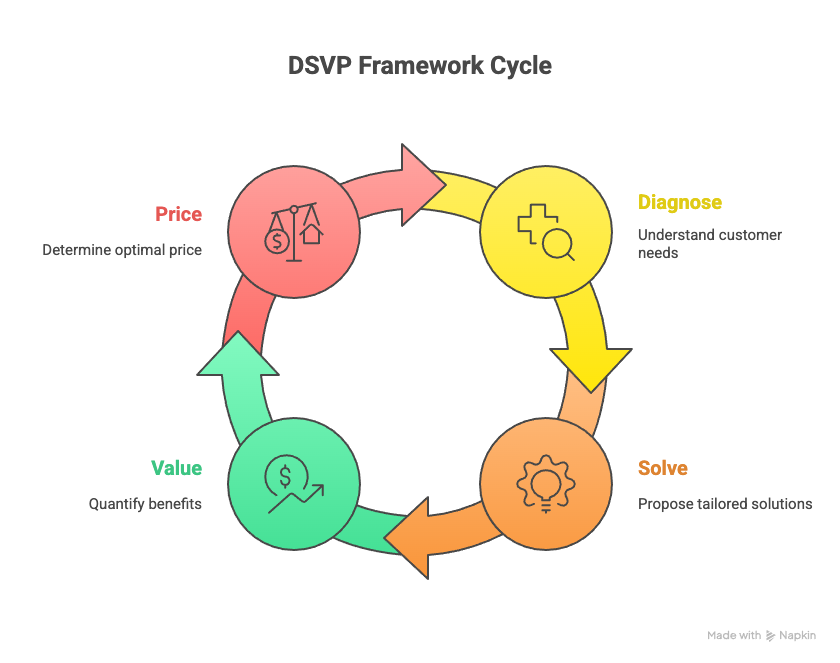The Diagnose, Solve, Value, Price Framework is a strategic approach widely used in sales, marketing, and product management to align customer needs with business offerings effectively. This framework guides professionals through a clear, step-by-step process: first, identifying the customer’s problem (Diagnose), then delivering a tailored solution (Solve), clarifying the benefits and worth of that solution (Value), and finally determining the appropriate cost point (Price). By following this sequence, businesses can enhance customer satisfaction, justify pricing decisions, and build stronger relationships. This article explores each stage in depth, showing how integrating the Diagnose, Solve, Value, Price framework can lead to more effective decision-making and better overall results.

Diagnose: understanding the problem deeply
The initial stage, Diagnose, is critical because it sets the foundation for all subsequent actions. This phase involves thoroughly analyzing the customer’s pain points, challenges, or unmet needs. Effective diagnosis requires asking the right questions, actively listening, and gathering relevant data to uncover root causes rather than just symptoms.
For example, a software company might start by identifying inefficiencies in a client’s workflow rather than assuming which features are valuable. This approach allows businesses to position their offerings as a direct response to real problems, increasing the likelihood of engagement and success. Without accurate diagnosis, efforts to solve problems risk being misaligned or superficial, which can harm trust and reduce impact.
Solve: providing tailored, effective solutions
With a clear understanding of the problem, the next step is to Solve it using targeted solutions. This phase is about crafting or configuring products, services, or processes that address specific issues diagnosed earlier. Solutions should be practical, scalable, and directly linked to the customer’s primary pain points.
Instead of generic offerings, solutions tailored with insight often lead to higher adoption rates and customer satisfaction. For instance, customizing training programs for a client’s unique operational challenges demonstrates attention to detail and commitment to their success. Importantly, the solve stage must include validation to confirm the solution’s effectiveness, either through testing, pilots, or ongoing feedback loops.
Value: articulating the benefits clearly
After implementing solutions, it’s essential to Value them correctly by communicating their advantages in terms the customer understands and cares about. Value is not just a measure of cost savings or increased revenue; it encompasses improvements in productivity, risk reduction, user experience, and long-term sustainability.
A compelling value presentation links the solution’s features to tangible outcomes. This often involves translating technical details into business language. For example, rather than highlighting a product’s advanced encryption, a salesperson might emphasize how it protects sensitive data, reducing the risk of costly breaches.
The table below illustrates common value drivers and their related customer benefits:
| Value driver | Customer benefit |
|---|---|
| Cost reduction | Lower operational expenses |
| Quality enhancement | Improved product/service reliability |
| Speed | Faster time to market or delivery |
| Risk mitigation | Minimized exposure to potential losses |
| Customer satisfaction | Higher retention and loyalty |
Price: setting the right cost based on perceived value
The final step in the framework is Price, which balances business objectives with customer expectations. Successful pricing is not arbitrary but reflects the solution’s value proposition and market context. Pricing strategies might include cost-plus, value-based, or competitive pricing, among others.
It’s essential that pricing aligns with the value communicated to avoid perceptions of overcharging or poor investment. When customers recognize the benefits are worth the price, objections diminish, and negotiations become more straightforward. Transparent pricing discussions that connect directly to previously outlined value points build trust and justify the investment.
For example, a SaaS provider might offer tiered pricing to reflect different levels of functionality, allowing customers to choose what fits their budget and needs best while perceiving clear value at each level.
Conclusion
The Diagnose, Solve, Value, Price framework provides a logical, customer-centric path for delivering impactful solutions and communicating their worth effectively. Starting with precise problem diagnosis ensures that efforts are relevant and focused. Crafting tailored solutions addresses these needs directly, while articulating value translates technical benefits into customer-centric outcomes. Finally, setting a price aligned with perceived value encourages trust, reduces friction, and supports sustainable business growth.
When used well, this approach not only improves sales and marketing effectiveness but also deepens customer relationships by emphasizing understanding and responsiveness. In a competitive market, the framework acts as a roadmap to create offerings that resonate both strategically and economically, driving long-term success for both businesses and clients.
